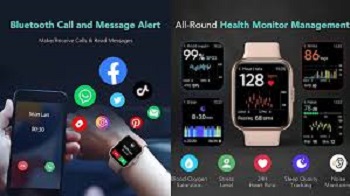1. What is a Smartwatch?
A smartwatch is a wearable computing device designed like a wristwatch but with advanced digital features. Unlike traditional watches that only show time, smartwatches can connect to smartphones via Bluetooth or Wi-Fi. This allows users to receive calls, read text messages, check emails, use apps, and even make contactless payments directly from their wrists. Some smartwatches even function as standalone devices with built-in SIM cards and internet connectivity.
2. Health and Fitness Benefits
One of the most important uses of smartwatches is in the field of health and fitness. These devices help people monitor their daily activities and encourage them to live a healthier lifestyle.
-
Heart Rate Monitoring – Smartwatches measure heart rate in real time, helping users track cardiovascular health and detect abnormalities.
-
Step Counter and Calorie Tracking – By counting steps and estimating calories burned, smartwatches encourage people to stay active.
-
Sleep Monitoring – Smartwatches analyze sleep patterns, including deep sleep, light sleep, and awake times, helping users improve rest quality.
-
Workout Tracking – Whether running, cycling, swimming, or yoga, smartwatches record workout sessions and provide performance reports.
-
Stress Management – Many smartwatches include breathing exercises and relaxation reminders to reduce stress.
-
Medical Alerts – Advanced smartwatches can detect irregular heartbeats, falls, or abnormal oxygen levels and send alerts to family members or doctors.
Thus, smartwatches are not just gadgets—they act as personal health assistants.
3. Communication and Connectivity
Smartwatches make communication easier and faster by bringing smartphone features directly to the wrist.
-
Call and Message Notifications – Users can answer calls, send quick replies, and read messages without taking out their phones.
-
Email and App Alerts – Important notifications from apps like WhatsApp, Gmail, or social media can be checked instantly.
-
Voice Assistants – Smartwatches come with AI assistants like Siri, Google Assistant, or Alexa, allowing voice commands for various tasks.
-
Emergency Features – Some smartwatches have SOS buttons that can send the user’s location to emergency contacts during dangerous situations.
This constant connectivity makes smartwatches extremely convenient for busy professionals, travelers, and students.
4. Productivity and Daily Life Management
A smartwatch is like a mini personal organizer that keeps life more productive.
-
Reminders and Alerts – Users can set alarms, reminders, and calendar notifications to manage daily schedules.
-
Navigation Support – Built-in GPS helps with directions while driving, cycling, or walking. Instead of constantly checking a phone, users can glance at their watch for maps.
-
Contactless Payments – With apps like Apple Pay, Google Pay, or Samsung Pay, users can make secure payments directly from their smartwatch.
-
Music and Entertainment – Smartwatches allow users to control music, listen to songs, or even store playlists for workouts.
-
Work Efficiency – Professionals can receive meeting reminders, reply to urgent emails, and stay connected without being distracted by their phones.
Thus, a smartwatch saves time and increases efficiency in daily activities.
5. Lifestyle and Fashion
Apart from technology, smartwatches are also considered fashion accessories.
-
Customizable Designs – Users can change watch faces, straps, and themes according to personal style.
-
Trendy Look – Wearing a smartwatch gives a modern and stylish appearance.
-
Personalization – Features like photo backgrounds, fitness goals, and notifications allow customization to suit individual needs.
Smartwatches combine fashion with functionality, making them attractive to both young and older generations.
6. Advantages for Students and Professionals
Smartwatches are particularly useful for students and working professionals.
-
For Students: They can set class reminders, track study schedules, monitor health during exams, and reduce phone distractions.
-
For Professionals: They can manage meetings, receive notifications silently, and stay productive during office hours without constantly checking their phones.
This makes smartwatches a valuable tool for education and career growth.
7. Challenges and Limitations
Although smartwatches provide many benefits, they also have some limitations.
-
Battery Life – Most smartwatches need charging every 1–2 days, which can be inconvenient.
-
Small Screen – Reading long texts or emails on a small screen can be difficult.
-
Cost – High-quality smartwatches are expensive, making them unaffordable for many people.
-
Dependence on Smartphones – Many smartwatches rely on smartphones for full functionality.
Despite these drawbacks, the advantages of smartwatches often outweigh the disadvantages.
8. Future of Smartwatches
The future of smartwatches looks extremely promising. With advancements in artificial intelligence, smartwatches are expected to become even more powerful and independent. Future devices may include advanced medical sensors, improved battery life, holographic displays, and more integration with smart homes and cars. Smartwatches will continue to play an essential role in personal health, communication, and lifestyle management.


You must be logged in to post a comment.